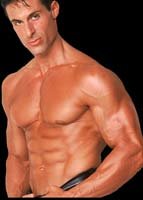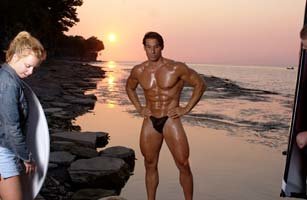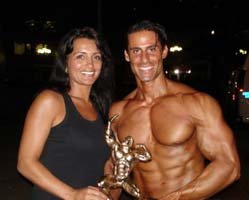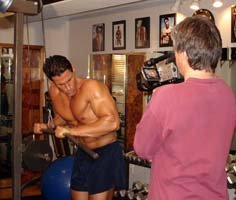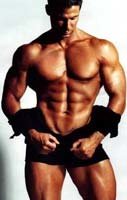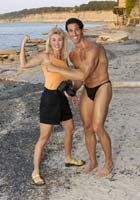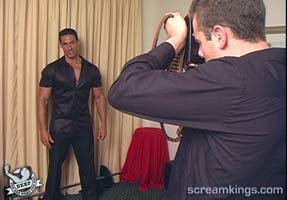As bodybuilders we strive daily to achieve superior physical development, so ultimately—whether on the stage or on the beach—our muscles can be shown in their best possible light. The sense of achievement that goes hand in hand with attaining good muscle development, as well as the ultimate reward, superior health, are great reasons for beginning, and continuing, a bodybuilding program.
However, there are certain times when we look our best (in the weeks leading up to a contest, for example). Also, with advancing age we tend to lose muscle and conditioning, our best years become a pleasant memory to reflect on as time erodes the Herculean physiques we once possessed.
One of the best ways to preserve the results of our bodybuilding efforts is to immortalize our physique in the form of a still image. Having quality photos taken is a great way to capture the hard work and sacrifice bodybuilding requires, either as a way to chart progress, launch a career in modeling, or simply reflect on a key moment in ones life.
Good photos can allow one to gauge their progress periodically, and make changes wherever applicable—they serve as indicators of progress and sources of motivation, which can inspire one to keep reaching to achieve their goals. Should one reach a sufficiently high level of development and/or acquire a certain desirable look, quality photos become an essential marketing tool to further career prospects in the growing modeling and fitness industries.
Ultimately, good photos serve as a reminder of the achievements one has made. Your photos can be a source of inspiration for others working their way to physical greatness. Having said all of this, nothing is worse than an average photo that does not display the body to its best advantage.
Bad photos can actually distort the physique, making it appear at well below its best. If photos are to be taken it is best to get it right the first time.
Having quality photos taken can be approached in several ways: the best method would be to use a professional who knows exactly what they are doing, as this takes the guesswork out of the equation. However, the amateur photographer can take good photos by following some sound guidelines.
The following interview with resident modeling expert, Anthony Catanzaro, provides a comprehensive review of exactly what is needed to achieve the perfect image of ones physique at its best. Anthony himself has modeled in many professional photo shoots, and is on first name basis with some of the finest photographers in the USA.
As a bodybuilder, he regularly has photos taken to chart his progress and he knows exactly what to look for. This article will also provide a detailed list of pointers that will help you to capture that perfect shot. To preserve your physique in its best light, read on.

[ Q ] What are some of the key requirements a bodybuilder should focus on when preparing for a photo shoot?
The number one thing a bodybuilder needs to focus on is becoming as lean as possible prior to the shoot. The camera will add at least 15 lbs, so don't focus on being big and bulky, because a 150lb shredded guy with 3% body fat, will look better than a 225 lb guy with 10% body fat. The camera creates an illusion.

[ Q ] How lean must a bodybuilder be before considering a photo shoot? Are there any tricks to enhance that lean look for the camera? 
There aren't any tricks, but what a bodybuilder needs to always keep in mind is everyone has certain positions they look better in. For me, it's posing a little to the side in more of a 3/4 stance to the camera. That is my best angle. I feel that I don't look as good straight on.
My waist looks narrower to the side than it is head on. The best thing to do is practice some poses in the mirror to see your best angles. Remember, its all about presentation. Image is everything.

[ Q ] To capture the physique at its best, what would be the ideal time to shoot? Should an athlete have photos taken before the contest or after the contest? What time of day would be best?
Good question. I have done shoots right before a show, the day of a show and one month before a show. But the best time to shoot is after a show, like a week or two after. Here's why, if you shoot before a contest, your face is a bit depleted and your vascularity isn't at its peak.
You can have some carbs before the shoot, or simple sugars to get some veins out but the bottom line is its not going to do much good. If you shoot a week or two after the show your face is much fuller from the water you are now holding, and your veins are going crazy from all of the carbs you have been eating. Plus you will feel 100% better as well. I always say shooting before a show is like taking a photo of a flat tire. Shoot afterwards and you'll be pumped up mentally and physically.

[ Q ] Can regular photo shoots be used as an assessment tool for bodybuilders? How often and how would these sessions be conducted?
I always like to use photographs as my guide, to see where I am as far as my pre-contest dieting is going. Sometimes you will look in the mirror and think you are lean enough, but a photograph tells the story a whole lot better.

[ Q ] How important is lighting, when wanting to capture the physique at its best? 
Lighting is everything. I love shooting on the beach or outside, because the natural sun is the best light. The only problem with that is the light won't stand still. So planning an outdoor shoot requires a lot of attention to weather, sunlight, and location. Shooting indoors can be great if the photographer understands the importance of light.

[ Q ] How important is facial expression? What expressions are needed and under what circumstances can they be used? 
Well here's the thing: your facial expression should be natural. I laugh when guys try to copy a pose or look from another bodybuilder. It just doesn't work that way. What works for him or her may not work for you. I became a success in this business because I have my own look.
I never wanted to follow in anyone's footsteps. I wanted to make my own footsteps for people to follow. I have a good smile because when I smile it comes from my heart, so use whatever you have that comes natural to you use it. If you have a tough look, go with it.

[ Q ] How would you groom the face, body and hair prior to a photo shoot?
This would all depend on the look I'm trying to achieve. I try to keep my hair medium length so I can groom it into different looks. Although I just recently cut my hair short for the summer, it was a good thing with this 100-degree heat. You need to experiment with what looks best on you and what suits your personality. Stay true to yourself and you will be true to others.
Check out my grooming article for the best presentation you can give.

[ Q ] What would be some of the best occasions to get professional photos taken? How would you plan for these occasions?
Any occasion is a good occasion to have photos taken. Remember, a photograph is an image instilled in time that is saved forever. Wouldn't it be nice to show your grandchildren all the muscles you had? Imagine being 80 years old and there is a huge photo of you when you were 25 all pumped up at your party. Wouldn't that be nice to look back on when you're old and grey?

[ Q ] What a great memory to look back on. To achieve such an image, what steps would you take to prepare for a photo shoot? 
Besides dieting, to get as low in body fat as possible, I would work on my tan. This can be done outdoors or in a tanning salon. Refrain from using pro-tans and spray tans, because these leave your skin with an unnatural color.
Here's a funny story: one time I went on a photo shoot and I used some pro-tan before I went there. Well, the pro-tan looked so false they didn't even want to use the photos! That taught me a huge lesson that day: from now on it is best to do your tanning days before the shoot and stop tanning two days before your shoot so you are more evenly tanned - not red.

[ Q ] What are the main differences between indoor and outdoor shooting? What should the athlete do differently in each stetting?
That's up to the photographer. So that is why it's important to shoot with someone who is experienced in both indoor and outdoor shooting. The photographer will shoot you in what I call "The best light."
That simply means he will use lighting and angles to bring out the best in what you can offer.

[ Q ] What should an athlete consider when shooting both indoors and outdoors? 
If you are shooting outdoors, use the sun as your guide. Always face the sun when you are shooting, because if you don't, you will be shadowed out as they say. The camera man's back should always be toward the sun, and if you are shooting indoors make sure your body and face are toward the light bulbs as this will pick up all of your definition.

[ Q ] How would a bodybuilder ensure their onstage photos are of a high quality? Do they need to assess the lighting and/or ensure everything is projected perfectly the whole time?
I own a Sony Cyber-shot 7.2-mega pixel digital camera. When I'm onstage, Tina would walk down to the front of the stage and just snap away. You don't need any extra lighting because the stage lights are perfect.
It is always a good idea to get some photos taken backstage when you are done competing or right after pre-judging. Find a nice background, and just hit some nice shots and make sure you have the setting on the highest level so that when you want to make a huge enlargement, you won't lose the quality.

[ Q ] What is the best way to find a good photographer? What qualities should a good photographer have?
He or she would need to have experience in whatever type of photos you will be doing. For instance, if you want quality bodybuilding photos, you don't want a guy that shoots wedding photos to take your picture. Get the point? He would probably focus on everything else but you.
All photographers have books that you can look through. These books will have their past work in them. Look through them and visit other photographers to find the one that's best for you.

[ Q ] What skills should a good photographer possess?
Most people think that great shots come from the models, but it's just the opposite. A good photographer will know in seconds how to shoot you, and bring out your very best. Think of it this way: how good would the covers of muscle and fitness look if they were taken from a 5-year-old child? So yes, experience is a must.

[ Q ] Describe your best ever bodybuilding/fitness photo shoot. Why was it as successful as it was?
I have to say it was my first cover shoot for Fitness Plus magazine. The only reason was because I knew it would be my first cover. That's when I met Sean Kahlil, my photographer and friend. He shot for MET-RX for years and is a great photographer for me here in NYC. Here is his web site: seankahlilphotography.com.
Irvin Gelb is also fantastic on the west coast.

[ Q ] What is the best photo you have had taken of yourself. What is it about this photo that makes it so good? 
I have to say this "looking down body shot" is everyone's favorite. The lighting is excellent and the feeling from the photo is excellent. In other words, the photo is very believable.
A photographer who worked for a fitness-training magazine took this photo. He was a very rude guy, so I never kept in touch with him. The shoot itself turned out bad, but this one shot was amazing. I put on this black cotton one-piece shorts outfit he gave me, I felt like a fool in it so I only wore part of it, and it worked! It turned out to be one of the best shots I ever took.

[ Q ] What are some tricks you use to enhance the quality of the session?
No tricks baby, just natural beauty (laughs). The number one thing is to make a connection with your photographer. You have to get comfortable with him or her; otherwise your photos will suffer. Here's why: if you don't feel comfortable while you're shooting, it will show in the photos and that's not a good thing.
You need to be 100% relaxed like I said before. Be yourself and don't copy other photos. Make your own for others to copy! Before the shoot get to know the photographer, ask questions and become personable with them. Who knows you might make a friend for life!
Here is a list of other photographers that are my friends that I have worked with.
- John Mitchell - www.bbpics.com
- Donna Kelly - dreamdesignsphotography.com
- William Koontz
Good luck with your photos and as always GOD Bless!
Anthony Catanzaro

Conclusion:
How To Achieve That Perfect Shot.
Having quality photos taken provides many returns on the investment you put into developing your physique to perfection.
-
Looking back on ones past efforts - using photos to reflect on - can provide a tremendous sense of achievement.
-
Bodybuilding progress can be charted, and adjustments can be made wherever needed, through the periodic comparing and contrasting of photos.
-
Good quality photos can enhance the reputation of one who is involved in the fitness industry (as a trainer, nutritionist, coach, or gym owner, for example), as these lend a degree of credibility to what they can achieve on a personal level.
-
Quality photos can lead to modeling work, and/or boost ones public profile to enhance their reputation as a professional.
To preserve your physique in the perfect image, the following can be done:
-
Choose the best lighting, and ensure you are facing toward the light (whether sun or artificial), as this will better highlight your definition. Photographing on overcast days can be a good strategy, as the soft light you get on such days produces the best skins tones. Also, side lighting (achieved by having the photo taken from a side angle) gives depth and form to the physique being photographed.
-
Have photos (for posterity or publication) done in your best possible shape, unless these are for progress charting purposes. In the weeks leading up to a contest, or the one week period following a contest, are often the best times for an "in shape" photo shoot.
-
Be relaxed. As Tony says, nothing looks worse than a forced facial expression. Be natural and everything will flow your way.
-
Develop a rapport with the photographer. You need to feel comfortable during the shoot; otherwise your uneasiness will show in the photos.
-
For the best quality photos, choose a reputable photographer who works with athletes similar to you, and therefore knows what to look for.
-
For good amateur bodybuilding shots, choose a good location backstage (after the pre-judging or night show), place the camera setting on a high level, and take photos of all the poses while the body is still pumped and the energy is still there.
-
Ensure a good, even tan (try to avoid excessive pro tan and the like). A good tan will highlight definition and project a healthy appearance.
-
Achieve low body fat levels. To highlight shape, proportion and muscularity body fat needs to be low. Getting to this level takes work, but the photos will last a lifetime.
-
Determine your best angles and poses. We all have a particular side, or stance that displays our physique at its best. Learn what works best for you, and emphasize this when shooting.
-
To add emphasis to the physique on display, use a zoom lens to shorten the sense of depth in the photo. This will throw the background out of focus, to highlight the subject.
-
When shooting the physique, try to maintain a reasonable degree of distance between the subject and the camera. Shooting too close to the athlete with a wide angle will distort their features. However, a wide angle is a good way to keep everything in focus, while helping to enhance depth in your shots so it should be used at certain times.
-
Be aware of how the physique is framed in your shot. For portraits, try to have the body "fit" the picture perfectly - nothing should look out of place.
-
Avoid red eye by turning up or providing more light in the room.
-
To produce a softer light, while avoiding harsh light, try not to aim the flash directly at the subject. Try to bounce it off a reflective or white surface.
-
Move around the subject when shooting, and take photos at a variety of angles. That perfect shot is a lot easier to get when there is a greater variety images to choose from.

